Cephalopod Characteristics
- Shell chambered (if present), reduced, or absent
- Prehensile tentacles surround mouth
- Mouth with radula and beak
- Muscular siphon provides jet propulsion
- Well developed brain, eyes
- Closed circulatory system
- Marine
| More Cephalopod Fossils
|
|
Subclass Nautiloidea — Nautiluses
Characteristics
- Shell chambered (coiled in extant forms, but straight in many fossil forms)
- 80-90 tentacles surround mouth
- Shell chambers connected by central siphuncle
- 6 extant species
- Marine environments, primarily deep water
- With fossil groups, may not be monophyletic
|

Chambered Nautilus, Nautilus pompilius
|

Median slice of a Chambered Nautilus, Nautilus pompilius, shell
|
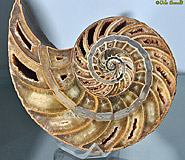
Cut fossil of Cymatoceras sp. nautiloid (Madagascar; Cretaceous); note the siphuncle
|
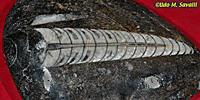
Fossil Geisonoceras sp., polished (Morocco; Devonian)
|

Internal mold of Nautiloid (Kentucky; Ordovician); note gaps (septa) are straight
|

Models of possible life appearance of some Paleozoic nautiloids
|
|
Subclass Ammonoidea†: Ammonites
Characteristics:
- Extinct
- Chambered shell; sutures that divide chambers have complex shapes
- Shell usually coiled (but there are exceptions)
- External shell often marked with knobs and ridges
More Ammonite Fossils
|
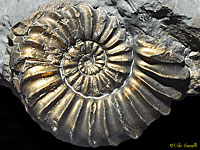
Ammonite fossil, Pleuroceras sp., with pyrite replacement of original shell (Germany; Early Jurassic Period)
|
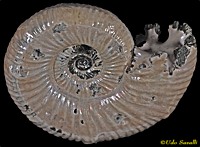
Ammonite fossil, Binatisphinctes rjasanensis, showing external shell and shape of septum (Russia; Late Jurassic Period)
|

Ammonite fossil, Perisphinctes sp., showing external structure (Late Cretaceous Period, SD)
|

Models of possible life appearance of various ammonites showing diversity. The top row are typical monomorph ammonites while the rest are heteromorph ammonites. Not to scale.
|
|
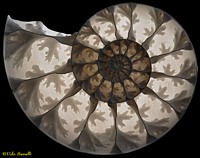
Model of a half shell of the Ammonite Phylloceras, showing the complex shapes of the septa
|
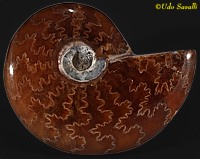
Ammonite fossil, Cleoniceras sp., showing sutures (Madagascar; late Cretaceous Period)
|
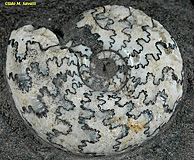
Ammonite fossil Craspedites nodiger, showing sutures (Russia; Jurassic Period)
|
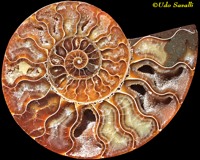
Cleoniceras sp. ammonite fossil cut to show chambers (Madagascar, early Cretaceous)
|
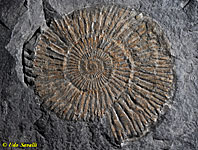
Dactylioceras sp. ammonite fossil (Germany, early Jurassic)
|

Part of an unusual straight-shelled ammonite, Baculites compressus, but note complex suture shapes that distinguish it from straight nautiloids (Late Cretaceous Period, SD)
|
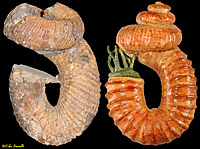
Fossil and model of possible life appearance of Nostoceras sp., a heteromorph ammonite
|

Crioceratites duvali, a heteromorph ammonite that is loosely coiled (Early Cretaceous Period, France)
|
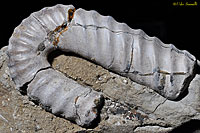
A heteromorph ammonite, Hamites maximus (Early Cretaceous Period, France)
|
|
Subclass Coleoidea: Squid, Octopuses, & Relatives
Characteristics:
- Shell absent or reduced and internal
- 8-10 tentacles/arms with suckers
- Force water from siphon for jet propulsion
- Release ink to confuse/deter potential predators
- All are predators
- All are marine
|
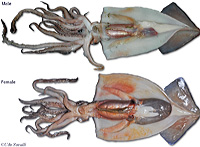
Dissections of large, fresh squid, probably Ommastrephes bartramii
See also labeled photo.
|
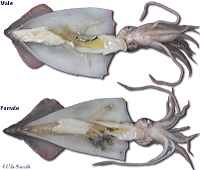
Dissections of small, fresh squid, probably Doryteuthis sp.
See also labeled photo.
|
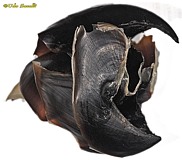
Beak of the Humboldt Squid, Dosidicus gigas; anterior is to the right (Order Teuthoida)
|
Clade Decapodiformes: Squid & Cuttlefish
|
Order Sepiida: Cuttlefishes
- 8 arms and 2 tentacles
- Internal shell ("cuttlebone") is calcified with tiny chambers to regulate buoyancy
- Body generally broader and with longer fins than in squid
- Near benthic in shallow waters

Cuttlebone, the internal shell of cuttlefish, most likely Sepia officinalis or S. pharaonis
|
|

Broadclub Cuttlefish, Sepia latimanus
|
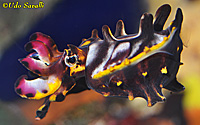
Flamboyant Cuttlefish, Metasepia pfefferi
|
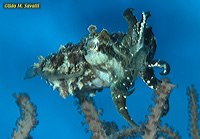
Stumpy-spined (or Dwarf) Cuttlefish, Sepia bandensis
|
|
Squid ("Teuthida")
- 8 arms and 2 tentacles
- Internal shell forms a cartilage-like (non-calcified) support
- Generally more elongated and streamlined with posterior fins than in cuttlefish
- Generally pelagic
- Divided into at least 2 orders: Myopsida (coastal squid) and Oegopsida (neritic squid)
|

Common Market Squid, Doryteuthis opalescens (Order Myopsida)
|

Giant Squid, Architeuthis sp., preserved specimen
Georgia Aquarium, Atlanta (Order Oegopsida)
|

Firefly Squid, Watasenia scintillans; preserved specimen (Order Oegopsida)
|
|
Other Decapodiformes:
- Order Spirulida contains a single extant species, the Ramshorn Squid
- Belemnites are extinct squid-like animals with internal shell
More Coleoid Fossils
|

The coiled internal shell of the Ramshorn Squid, Spirula spirula
|

Two fossil rear guards of belemnites and their approximate position in belemnite models
|

Fossil of an extinct squid, Dorateuthis syrica, showing rare soft-tissue preservation, including arms
|
Clade Octopodiformes
|
Order Octopoda: Octopuses:
- 8 arms only
- Lacks any shell
- Body rather bulbous; not streamlined
- Primarily benthic
- Vampyromorphida (the "vampire squid") are in a separate order in the Octopodiformes
|
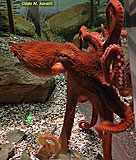
Pacific Giant Octopus, Enteroctopus dofleini
|
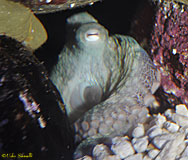
Two-spot Octopus, Octopus bimaculoides
|

Juvenile Two-spot Octopus, Octopus bimaculoides; La Jolla, CA
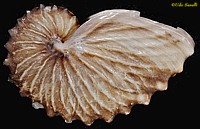
Brown Argonaut egg case, Argonauta hians
|
|
|



































